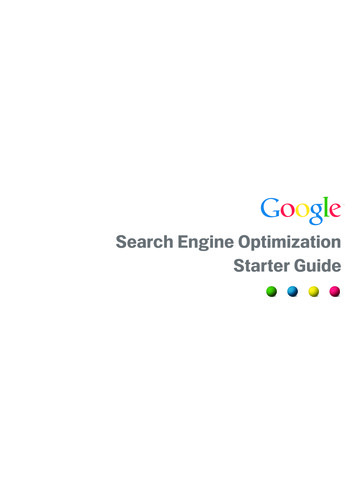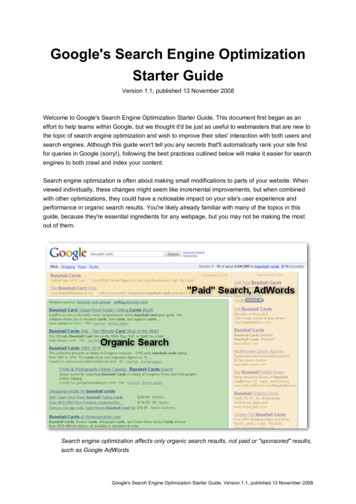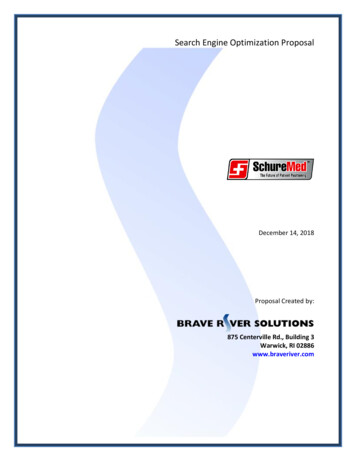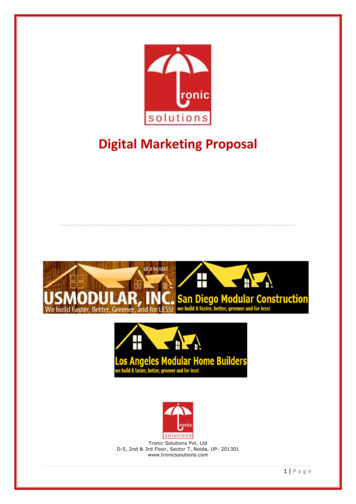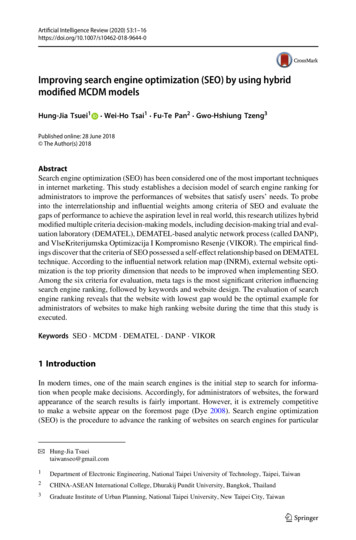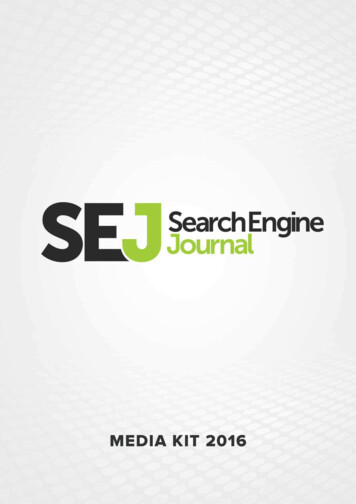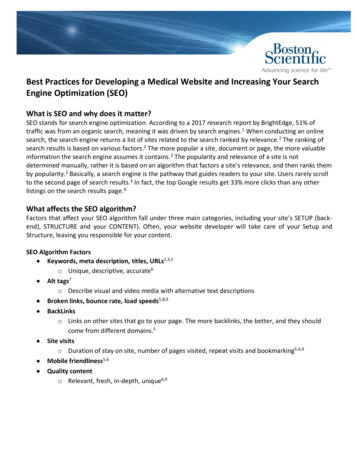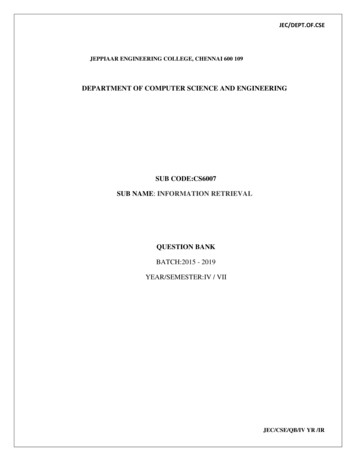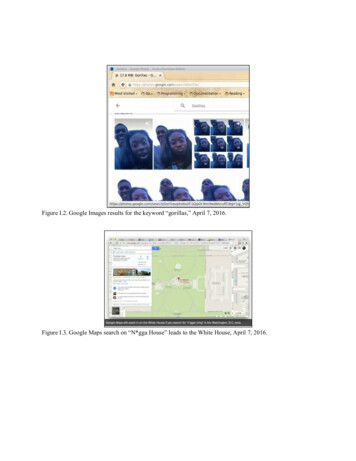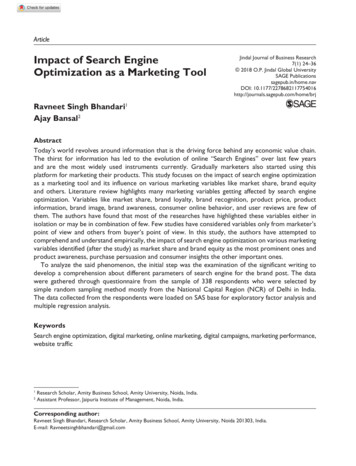
Transcription
ArticleImpact of Search EngineOptimization as a Marketing ToolJindal Journal of Business Research7(1) 24–36 2018 O.P. Jindal Global UniversitySAGE Publicationssagepub.in/home.navDOI: m/home/brjRavneet Singh Bhandari1Ajay Bansal2AbstractToday’s world revolves around information that is the driving force behind any economic value chain.The thirst for information has led to the evolution of online “Search Engines” over last few yearsand are the most widely used instruments currently. Gradually marketers also started using thisplatform for marketing their products. This study focuses on the impact of search engine optimizationas a marketing tool and its influence on various marketing variables like market share, brand equityand others. Literature review highlights many marketing variables getting affected by search engineoptimization. Variables like market share, brand loyalty, brand recognition, product price, productinformation, brand image, brand awareness, consumer online behavior, and user reviews are few ofthem. The authors have found that most of the researches have highlighted these variables either inisolation or may be in combination of few. Few studies have considered variables only from marketer’spoint of view and others from buyer’s point of view. In this study, the authors have attempted tocomprehend and understand empirically, the impact of search engine optimization on various marketingvariables identified (after the study) as market share and brand equity as the most prominent ones andproduct awareness, purchase persuasion and consumer insights the other important ones.To analyze the said phenomenon, the initial step was the examination of the significant writing todevelop a comprehension about different parameters of search engine for the brand post. The datawere gathered through questionnaire from the sample of 338 respondents who were selected bysimple random sampling method mostly from the National Capital Region (NCR) of Delhi in India.The data collected from the respondents were loaded on SAS base for exploratory factor analysis andmultiple regression analysis.KeywordsSearch engine optimization, digital marketing, online marketing, digital campaigns, marketing performance,website traffic12Research Scholar, Amity Business School, Amity University, Noida, India.Assistant Professor, Jaipuria Institute of Management, Noida, India.Corresponding author:Ravneet Singh Bhandari, Research Scholar, Amity Business School, Amity University, Noida 201303, India.E-mail: Ravneetsinghbhandari@gmail.com
Bhandari and Bansal25IntroductionInternet connectivity is ruling the globe in current scenario, and it is virtually unfeasible to find anythingon the web without utilizing a search engine. But the question is what this search engine is? A searchengine is complex software which may be compared to be a finder visiting to the various websites andtheir pages which help the searcher to find significant data (Levene, 2010). Search engine optimization(SEO) can be defined as a mechanism which allows the searcher to get most appropriate results of hisonline search. SEO also helps marketers by displaying their respective ads to the right people in the rightplace and right time. Marketers can advance the rankings of their advertisement on the search-resultspages by improving their quality score in order make them more significant and therefore more searchengine compatible (Sen, 2005).Search engines can be classified into three sorts: Crawler-based search engines: Crawler or Spider programs create databases by methods for webrobots. These robots are programs that dwell on a host system and recover data from destinationson the web utilizing standard conventions. Basically, they naturally venture to every part of theWeb taking after connections from records and gathering data as indicated by the HTML structureof the record (Thelwall, 2015).Human-powered directories: Human-powered directories additionally alluded as “open indexsystem” relies upon human-based exercises for postings. Site proprietor presents a short portrayalof the site to the registry alongside category it is to be recorded. Submitted site is then physicallylooked into and included the suitable class or rejected for posting. Keywords entered in the searchbox will be coordinated with the portrayal of the locales. A decent site with great substance willprobably be assessed for nothing contrasted with a site with poor substance (Burghardt, Heckner,& Wolff, 2012).Hybrid search tools: Hybrid search engines utilize both crawler-based and manual ordering forpostings the locales in list results. A large portion of the crawler-based web indexes like Googlefundamentally utilizes crawlers as an essential component and manual screening as an auxiliaryinstrument. At the point when a site is being distinguished for spam exercises, manual survey isrequired before incorporating it again in the query items (Ahlers, 2012).Attributable to the massive amount of data on the Web, ideal from the beginning of the Web, web crawlers have turned into an irreplaceable instrument for web clients. The underlying foundations of searchengine innovation are in data recovery systems, which can be followed back to the work at IBM amidthe late 1950s. Data recovery has been a dynamic field inside data science from then and has been givena major lift since the 1990s with the new prerequisites that the Internet had brought (Oppenheim, Morris,McKnight, & Lowley, 2000). One of the issues related with the assessment of web search tools is thereality that they are always showing signs of change, and building up their search instruments and userinterface. Also, consistently observes the innovation of new web search tools. Joining these truths withthe always showing signs of change substance of the web, it is clear that no particular assessment of anInternet search engines is probably going to stay legitimate for any period of time. Subsequently, mostresearchers stress that the results of the search engines are just demonstrative of the execution of thoseweb crawlers around at that time only (Kammerer & Gerjets, 2012).
26Jindal Journal of Business Research 7(1)Process of Surfing on Search EngineFor the search engine methodology, a client looking for data on the Internet will ordinarily repeat throughthe accompanying steps:1.2.3.4.Question detailing: The client presents an inquiry to the search engine indicating his or her objective; ordinarily a question comprises at least one info keywords.Determination: The client chooses one of the site pages from the positioned comes about rundown returned by the web index, taps on the link to that page, and peruses the page once it isstacked into the server.Surfing: The client starts a surfing session, which is the way toward tapping on links and perusingthe pages showed. The client surfing the Web by taking after connections will utilize differentsignals and devices to expand his or her navigational movement.Inquiry adjustment: The surfing session might be hindered for the reason of inquiry adjustment,when the client chooses to reformulate the first question and resubmit it to the web crawler.For this situation, the client returns to step one (Schwartz, 1998).Search Engine DesignThe design of a search engine can be seen in Figure 1.Usually when a client enters a search query into a web crawler, it is a couple keywords. The web indexhas the names of the destinations containing the keywords, and these are in a flash acquired from the file.The genuine preparing load is in producing the site pages that are the search items list. Every page inthe whole rundown must be weighted by data in the web indexes. Then the top search query outputrequires the lookup, reproduction, and markup of the scraps demonstrating the setting of the keywordsFigure 1. Architectural Design of Search EngineSource: Chekuri, Goldwasser, Raghavan, and Upfal (1997).
Bhandari and Bansal27coordinated. These are just piece of the preparing each indexed lists page requires, and additionallypages (alongside the top) require a greater amount of this post handling (Harter & Hert, 1997).Search Engines and Marketing in the Contemporary ScenarioGoogle has turned search engine into the essential device used to find data on the web. A few reviews onclient behavior showed that most clients click on sites recorded on the first page of results and the extentof clients that view sites recorded beyond the third page of results declines quickly. Accordingly, accomplishing a high positioning in web index results is pivotal to pulling in traffic to a site and speaks to thecentral purpose of search engine advertising endeavors (Luh, Yang, & Huang, 2016).SEO assist to improve the positioning of a site for the query results for given keywords. SEO systemincorporates two main procedures: Off-page optimization and On-page optimization. Off-page optimization involves creating back connections on other authenticated websites and subsequently boostingdomain-level and page-level authentication. For On-page optimization, SEO creates the advancement ofwebsite pages utilizing target keywords in the title, snippets and in the URL. The inclusion of extraterms, semantically identified with the objective keywords, is viewed as a progressed SEO strategy(Moreno & Martinez, 2013).Objectives of the Study To understand the impact of SEO on the marketing performance of the brand.To compare SEO as an advertising tool with other traditional marketing tools.To identify the implications on the customer’s perception about SEO as a marketing tool.Review of LiteratureVarious researchers have illustrated about the SEO and its importance in our daily life. Search enginemarketing is the quickest developing promoting medium on the planet, anticipated to progress towardbecoming many times more intense and powerful than customary media outlet. Search engines are theessential search tools utilized for data recovery on the Web. It has been assessed that most of Web clientsutilize search engines to acquire data from the Web. This highlights the fundamental significance ofwebsite pages being recorded with web search tools. An essential system for any site proprietor is arranging how guests can discover their way to their specific website (Berman & Katona, 2013). The searchengine acts as a mediator amongst shoppers and sites. It will likely furnish shoppers with links to themost noteworthy quality sites on the organic side. To rank sites, the web search tool scores every site onits assessed quality utilizing data assembled from the Internet utilizing crawling calculations and information mining strategies. The users while utilizing a search engine are affected by the search enginemarketing decisions made by site proprietors and by the mechanism of the search engine. Site proprietors can decide to put resources into SEO push to advance their site in organic postings and also offer forsponsored connections (Lovatt & Legge, 2014). SEO matters in light of the fact that without it a site orthe webpage will show up lower in the search results it conceivably could what’s more, therefore will getless visits (Xu, Chen, & Whinston, 2012).Marketers utilize SEO to build the position of their postings in the organic indexed search results whichare created by the search engine’s restrictive ranking calculations. The positioning depicts the importance
28Jindal Journal of Business Research 7(1)of the match between the searcher’s search inquiry and the sites in the web crawler’s file. With SEO,marketers attempt to improve their websites so they are seen as more significant by the rank in order togain better market share (Sen, 2005). SEO is favorable for marketers because they do not have to spendfor web traffic from organic ads. Another significant aspect about SEO is it provides continuous and realtime insights about the online behavior of the consumer. Thus, SEO is a need to be performed on an ongoing basis. Comparing SEO with the traditional methods of marketing, the analysis of results and predictionof consumer behavior usually take months to manifest, on the contrary, SEO provides real-time analysisof consumer online behavior. SEO offers markets a more knowledgeable medium to emerge for requiredsearch queries at high ranks on the search engines (Yang & Ghose, 2010). The cost of a webpage facilitating services is diminishing; this approach would undoubtedly turn online marketing to be less expensive.In such a situation, there would be expanding number of on-line venders providing SEO services. All theleading search engines constructed a logical model that makes it conceivable for the marketers to comparesearch engine marketing strategies in terms of their impact on the profitability of on-line marketers(Taylor, 2013). On-line purchasers utilize search engines to scan for and price information. In the processof finishing the search process, the purchaser structures a thought set that comprises the dealers whosewebsites were visited during the search. Site URLs in print ads, marketers, draw the attention of the targetaudience to their Web destinations search engines have turned into a starting point for information searchesand a navigational aid to finding pages on the Internet. The SEO is for the most part considered to eitherbe a substitute for or a supplement to traditional media (Chen & He, 2011). Search engines rank searchquery results based on wide range of algorithmic and quality factors. Anyone can get you more traffic,however, would they be able to get you traffic focused to your business keywords that creates qualitychanging over leads. At the point when done appropriately by experts, SEO can get an enormous advantage of site improvement is round the clock marketing. A very much enhanced site will rank throughoutthe day consistently (Lorigo et al., 2006). Marketer can reduce server stress and load times, which lead tospeedier pages, happier search engine spiders, and retained visitors by validating code and optimizingfiles. The best favorable position of SEO administrations is sales! The website is effortlessly accessible tothe huge part of the online clients. A superior streamlined and outlined site magnetizes lot of searchers(Smith, 2010). The act of SEO can altogether build a better website ranking, driving more traffic movement to the site, and subsequently expanding revenue (Zhang & Cabage, 2016). SEO is an essential apparatus to expand a webpage’s visibility for marketers who can bear to pay more. The larger part of onlinesponsors put resources into both SEO also, sponsored search engine marketing and faces a vital problemin the matter of how to dispense their financial plan between the two exercises (Roy, Datta, & Basu, 2016).SEO will be around as long as search engines are around and search engines will be around as long asindividuals search for data (Dover, 2011).Research Design“Web search tool” is a developing marvel, so an exploratory research was conducted for comprehensionof different viewpoints. The researcher inspected the diverse publicizing elements of the search enginesthat affect the gathering of the users toward the substance of the page on the different web search tools.Causal research configuration actualized to comprehend the effect of web crawler on the segmentsof publicizing recognized under writing survey. The framework had been incited to detail a subjectivesystem for overhauled understanding for this complex and dynamic phenomenon. To break down thissubject, the underlying stride was the examination of the noteworthy composition to build up an understanding about various parameters of search engine for the pay per click marketing strategy. A sorted out
29Bhandari and Bansalpoll was readied which was ordered into two segments, the first section enquires about the demographicstatistic and web crawler profiles of the respondents and the second section measures the respondents onthe premise of parameters distinguished through literature audit. A 5-point Likert scale was intended toquantify the recognized parameters extending from explicitly agree ( 5) to explicitly disagree ( 1) forthe distinguished factors. The information was accumulated through survey from 338 respondents whichwere chosen by basic arbitrary examining strategy for the most part from the National Capital Region(NCR) of Delhi in India. The information gathered from the respondents was stacked on SAS base foradvance statistical investigation.Research ProcessThe investigation took after a successive procedure, moving through three noteworthy stages where eachstage took after particular strategies that are recorded as take after:1.2.3.Identification of all the conceivable factors which sets up pay per click as a promoting instrumentthrough literature audit.Combining the factors into important number of elements by means of exploratory factoranalysis.Study the connection between the factors for theoretical testing by means of multiple regression.Data Analysis and InterpretationDescriptive statistics conducted on the demographic and search engine profile of the respondents, theresult presented in Tables 1 and 2.Table 3 explains the univariate analysis of the identified variables which were employed for exploratory factor analysis. The variables with high mean values, that is, user reviews (mean 3.39), consumerdissonance (mean 3.21), and brand loyalty (mean 2.91) brand commitment (mean 2.90) areconsidered to be most impactful variables for the emergence of SEO as a marketing tool.Table 4 describes Kaiser’s measure of sampling adequacy: Overall MSA is 0.824 which is consideredto be an acceptable value; this indicates that the data collected would be suitable for factor analysis.Principal component analysis was employed to measure the degree of variability in the variables.The degree of variability calculated from the initial value ( 1), variables with extraction value more than0.5 would be considered acceptable for factor analysis.Table 1. Demographic Profile of the Respondents (N : Author’s compilation.Frequency83164856
30Jindal Journal of Business Research 7(1)Table 2. Search Engine Profile of the Respondents (N 338)Search EngineUsedFrequencyGoogleTime on SocialMedia (Minutes)FrequencyActivities onSocial 2095Information66Ask6 12045Source: Author’s compilation.Table 3. Descriptive Statistics of Identified VariablesVariablesMarket shareBrand commitmentBrand loyaltyBrand recognitionProduct priceProduct informationBrand imageInformation searchedConsumer dissonanceBrand awarenessSearch engine analyticsConsumer online behaviorUser reviewsFeedback mechanismScarcity of 76837–1.6707497–1.2559521–0.9416926Source: Author’s compilation.Table 4. Kaiser’s Measure of Sampling Adequacy: Overall MSA 0.82392075Final Communality Estimates: Total 10.739775Market oductpriceProductinformationBrand andawarenessSearchengineanalysisConsumeronline behaviorUserreviewsFeedbackmechanismScarcity 1*0.7859*Source: Author’s compilation.Notes: Initial value 1.* Extraction valueExtraction method Principal Component analysis.
31Bhandari and BansalTable 5 illustrates correlation between the each identified variables, the coefficient of correlationranges between –1 and 1, and coefficient of correlation greater than 0.5 is considered as an acceptablecorrelation between the variables.Table 6 illustrates Eigenvalue and cumulative proportion of the identified variables, these parametersassisted researcher to identify the number of factors. Eigenvalue close to 1 with cumulative proportionmore than 70 percent would be considered as an acceptable, all these parameters satisfied incase numberof factors equal to 5. Therefore, researcher accepted 5 factors.Table 7 illustrates the factor loadings of each identified variables, extraction method employed wasprincipal component matrix. Rotation method employed for factor analysis is varimax with KMOnormalization.Table 8 illustrates the profiling of the variables on the basis of rotated factor loadings. Each factorhad been profiled on the basis of the characteristics of the variables in the respective factor. Further toanalyze, the impact of SEO as a marketing tool on the factors was tested.Table 5. Correlation 250.350.420.450.260.4 90.330.390.370.510.550.490.410.410.521.00Source: Author’s compilation.Notes: X1* BudgetX2* Pure competitionX3* Monopolistic competitionX4* Mass marketingX5* Segment marketingX6* Niche marketingX7* OligopolyX8* Quality scoreX9* LanguageX10* MonopolyX11* KeywordsX12* Landing page experienceX13* Socio–cultural factorsX14* Ad relevanceX15* Demographic factors
32Jindal Journal of Business Research 7(1)Table 6. Eigenvalues of the Correlation Matrix: Total 15, Average 670.9901150.149034590.00991.0000Source: Author’s compilation.Table 7. Rotated Factor PatternVariablesFactor 1Consumer online behavior0.84940Information searched0.70352Consumer dissonance0.70094Feedback mechanism0.68786Search engine analytics0.65815Factor 2Brand commitment0.85183Brand loyalty0.74462Brand image0.63020Brand awareness0.46532Factor 3Brand recognition0.85794Product information0.65922Product price0.59063Factor 4User reviews0.87852Scarcity of products0.59117Market shareSource: Author’s compilation.Factor 50.76254
33Bhandari and BansalTable 8. Profiling of FactorsFactor 1Factor 2Factor 3Factor 4Factor 5Consumer onlinebehaviorBrandcommitmentBrand recognitionUser reviewsMarket shareInformation searchedBrand loyaltyProductinformationScarcity ofproductsConsumer dissonanceBrand imageProduct priceFeedback mechanismBrand awarenessSearch engine analyticsConsumer insightsBrand equityProductawarenessPurchasepersuasionMarket shareSource: Author’s compilation.HypothesisThe motivation behind this exploration is to research the advantageous impact of the SEO on the viewer’s response. With knowledge of the past writings and results of factor analysis the advantages of theSEO had been arranged into five fundamental measurements: H1: Greater the level of search engine optimization, the better consumer insights available to themarketer.H2: Greater the level of search engine optimization, the better brand equity available to themarketer.H3: Greater the level of search engine optimization, the better product awareness provided to theconsumer.H4: Greater the level of search engine optimization, the better purchase persuasion created bythe marketer for the user.H5: Greater the level of search engine optimization, the better market share available to themarketer.Hypothesis TestingThe hypothesized relationships were tested using multiple regression analysis. First of all a correlationsmatrix was produced to comprehend the relationships between reviewed variables. Considering thecorrelation matrix, consumer online behavior and consumer dissonance (0.691020), brand commitmentand brand loyalty (0.593567), and feedback mechanism and scarcity of the products (0.527474)indicated high degree of correlation. A 5-point Likert scale was designed (where 1 Strongly disagreeto the statement and 5 Strongly agree to the statement) to record responses of the respondents formentioned key variables then the whole gathered information was coded to SAS base version for
34Jindal Journal of Business Research 7(1)Figure 2. Advantages of Search Engine OptimizationSource: Author’s compilation, proposed conceptual model developed for the study.multiple regression analysis to check the legitimacy of the mentioned hypothesizes. The responsescollected from the respondents were normally distributed. The identified variables entered into theequation using “Enter method.” The hypothesized model for SEO is represented in Table 9. p-values inthe table is less than 0.0001, F-value 85.07, and adjusted R2 0.5558 which is acceptable, therefore all theestimated coefficients are statistically significant. The responses collected from the respondents werenormally distributed. The results of multiple regression shows that SEO offers advantageous benefits tothe marketer as well as to the consumer. Therefore, the researcher accepts H1, H2, H3, H4, and H5 asSEO have significant impact as a marketing tool in terms of identified factors, that is, market share,brand equity, product awareness, purchase persuasion, and consumer insights.Table 9. Results of Multiple t-valuePr t Intercept1–1.297370.20183–6.43 .0001Consumer insights10.353600.086894.07 .0001Brand equity10.161050.062682.570.0106Product awareness10.260270.064024.07 .0001Purchase persuasion10.588500.063859.22 .0001Market share1–0.037650.03795–0.990.3219F-valuePr FAnalysis of VarianceSourceModeldfSum ofSquaresMeanSquare5434.7817186.9563485.07 .0001Error332338.328081.02214Depd. Mean2.36000R2 0.5624Corrected Total337773.10979Root MSE1.01101Coeff Var43.29225Adj. R20.5558Source: Author’s compilation.
35Bhandari and BansalY C m1 1 m2 2 m3 3 m4 4 m5 5Predicted (Impact of SEO) –1.29737 (0.35360 * Consumer insights) (0.16105* Brand equity) (0.26027 * Product awareness) (0.58850 * Purchase persuasion) (–0.03765 * Market share).FindingsThe data gathered were normally distributed, as the data were checked for multi-collinearity and heteroscedasticity. The 15 variables were identified and were used for exploratory factor analysis which wasreduced to five factors by using the principal component analysis and varimax rotation method. Theidentified factors are as follows:Factor 1: Consumer insights consist of variables: consumer online behavior, informationsearched by the user, consumer dissonance after purchase, feedback mechanism, and searchengine analytics.Factor 2: Brand equity consists of variables: brand commitment, brand loyalty, brand image, andbrand awareness.Factor 3: Product awareness consists of variables: brand recognition, product information, andproduct price.Factor 4: Purchase persuasion consists of variables: user reviews and scarcity of products.Factor 5: Market share.The results of data analysis are segmented into two sections. The first section consists of descriptivestatistics of demographic and search engine profile of the respondents, and the majority of the respondents between the age of 20 and 25 years with graduate level of education uses Google as their prominentsearch engine for mostly 15–60 minutes in order to obtain updates and information. The second section,on other hand, consists of statistical and hypothetical analysis of the identified variables. SEO as amarketing tool (F-value 85.07 and p-value 0.0001) has significant impact on the consumers. The mostprominent advantages of SEO identified in the research is it helps to increase market share ( p-value 0.3219), enhances the brand equity of the marketer ( p-value 0.0106) followed by other factors, that is,product awareness, purchase persuasion, and consumer insights.ConclusionJust how big a difference will SEO make to the way customers buy things? The authors suspect that thisquestion hovers in the minds of most marketers. We can see the changes that are taking place, can trackthe explosive growth in access to the Internet, and can speculate about how marketing will transfer to thisexciting new medium. Hence authors examine the impact of SEO as marketing tool to understandthe marketing parameters which get impacted the most by SEO. In the e-shopping environment, i
Impact of Search Engine Optimization as a Marketing Tool Ravneet Singh Bhandari1 Ajay Bansal2 . 2016). SEO assist to improve the positioning of a site for the query results for given keywords. SEO system incorporates two main procedures: Off-page optimization and O
